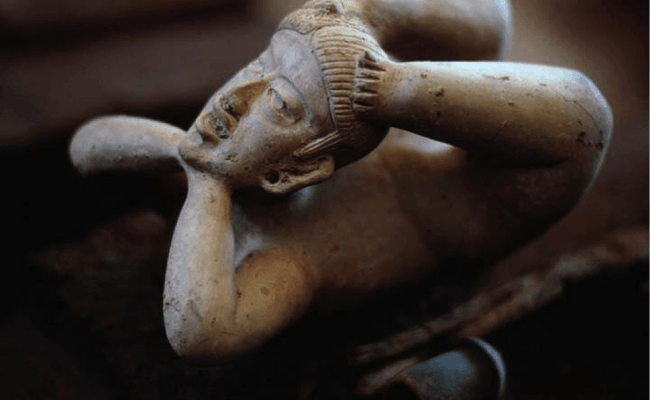SUPERCONVERSATIONS DAY 82: NATALIA VALENCIA RESPONDS TO GIULIANA BRUNO, “SURFACE ENCOUNTERS”
#On Mental and Museographic Gymnastics
“Acrobat”, mid pre-Classic period, (1200-600 BC). Tlatilco, Mexico State. Anthropology Museum, Mexico City.
By evoking the interest to delve further into hapticity as an embodied form of knowledge used to apprehend works in the contemporary museum, Giuliana Bruno’s text lead me to wonder about the meaning of these sensuous qualities within ethnographical and anthropological museography apparatuses. Which role does hapticity play when involved in the representation of human subjects? The highly didactic and sensorially expanding quality that Bruno finds in the technological evolution of cinema, exhibition display and museographic languages – an intensification of the spectator’s haptic responses, which in itself relies heavily on her/his perceptive disposition and cultural information- might not always be effective nor necessarily positive, as these languages are related to other sets of representational relations between the observer and the observed that are dictated by each institution’s specific historical background and political affiliations.
Ethnographic and anthropological museums have historically implemented a Western hierarchy of the senses to map the cognitive terrain of the exhibition –indissociable from a logocentric approach to the subject of study. We are well aware that the resulting institutional discursive strategies need to be put into dialogue with the specific sensorial hierarchies and cosmologies of the humans that are being represented. In order to withdraw from the predominance of the field of vision and strive to let other senses guide us through the polysemic space of knowledge that is an exhibition space, we must consider how beneficial the “haptic expansion” encouraged by Bruno can be, when it takes shape in the sensuous “spectacularization” of the subject on display. What if these devices/apparatuses do not “deliver” the intended sensorial messages or are failed from an ethnographic point of view? Ethical questions - like, what does it mean to be human and how to represent humanity - must be revised to ponder the effects of these material encounters and the public intimacy brought forward by this hypothetical haptic expansion. Perhaps I do not need to increase my ability to feel and generate contact with the subjects and objects on display and the information transmitted; perhaps, for the sake of an inclusive cosmopolitical interpretation, said cultural information is better absorbed through opaque and “non-expansive” channels that might be more aesthetically coherent with the represented subjects and objects and the sociopolitical interactions they are a product of.
Renzo Piano’s mechanical device setting Emilio Vedova’s paintings in motion at the Vedova Foundation in Venice does not render the same cultural purpose as the dusty dioramas representing indigenous rural scenes at the Museo de Antropología in Mexico City. The surface of a Vedova painting holds “the entirety of its meaning”, thus it might be susceptible to be successfully molded by the haptic expansion brought by Piano’s device. The ants walking on the floors and walls of the Galerie Sud space in Pierre Huyghe’s recent retrospective at the Centre Pompidou in Paris in 2013 were themselves “the art objects” and they did convey a haptic quality, but which was brought by their organic, living materiality. On the other hand, anthropological artifacts also possess the quality that Bruno concedes to the surfaces of art objects: the ability to “retain the inner structure of temporality and the folds of memory in [their] material substance.” That is precisely why the discursive forms and museographic devices used to display them need to be attentive to the ways in which temporality and movement are understood and exerted within the specific ontologies and cosmologies of the represented subjects. Each institution employs different “technologies of immersion”, and it seems difficult or at least problematic to unify them under a general instruction to “intensify bodily responses.” The “architectonics of memory” can build auspicious yet non-rippling, completely static mental structures through which we apprehend the world in museums.
Natalia Valencia is a curator from Colombia, living in Mexico City.
